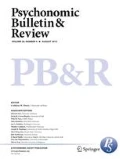Abstract
We examined the effect of item-specific and relational encoding instructions on false recognition in two experiments in which the DRM paradigm was used (Deese, 1959; Roediger & McDermott, 1995). Type of encoding (item-specific or relational) was manipulated between subjects in Experiment 1 and within subjects in Experiment 2. Decision-based explanations (e.g., the distinctiveness heuristic) predict reductions in false recognition in between-subjects designs, but not in within-subjects designs, because they are conceptualized as global shifts in decision criteria. Memory-based explanations predict reductions in false recognition in both designs, resulting from enhanced recollection of item-specific details. False recognition was reduced following item-specific encoding instructions in both experiments, favoring a memory-based explanation. These results suggest that providing unique cues for the retrieval of individual studied items results in enhanced discrimination between those studied items and critical lures. Conversely, enhancing the similarity of studied items results in poor discrimination among items within a particular list theme. These results are discussed in terms of the item-specific/ relational framework (Hunt & McDaniel, 1993).
Article PDF
References
Arndt, J., &Reder, L. M. (2003). The effect of distinctive visual information on false recognition.Journal of Memory & Language,48, 1–15.
Deese, J. (1959). On the prediction of occurrence of particular verbal intrusions in immediate recall.Journal of Experimental Psychology,58, 17–22.
Dodson, C. S., &Schacter, D. L. (2001). “If I had said it I would have remembered it”: Reducing false memories with a distinctiveness heuristic.Psychonomic Bulletin & Review,8, 155–161.
Dodson, C. S., &Schacter, D. L. (2002). When false recognition meets metacognition: The distinctiveness heuristic.Journal of Memory & Language,46, 782–803.
Gallo, D. A., McDermott, K. B., Percer, J. M., &Roediger, H. L., III (2001). Modality effects in false recall and false recognition.Journal of Experimental Psychology: Learning, Memory, & Cognition,27, 339–353.
Hunt, R. R. (1995). The subtlety of distinctiveness: What von Restorff really did.Psychonomic Bulletin & Review,2, 105–112.
Hunt, R. R. (2003). Two contributions of distinctive processing to accurate memory.Journal of Memory & Language,48, 811–825.
Hunt, R. R., &McDaniel, M. A. (1993). The enigma of organization and distinctiveness.Journal of Memory & Language,32, 421–445.
Jacoby, L. L. (1991). A process dissociation framework: Separating automatic from intentional uses of memory.Journal of Memory & Language,30, 513–541.
Johnson, M. K., Hashtroudi, S., &Lindsay, D. S. (1993). Source monitoring.Psychological Bulletin,114, 3–28.
Koriat, A., Goldsmith, M., &Pansky, A. (2000). Toward a psychology of memory accuracy.Annual Review of Psychology,51, 481–537.
Koutstaal, W. (2003). Older adults encode-but do not use-perceptual details: Intentional versus unintentional effects of detail on memory judgments.Psychological Science,14, 189–193.
Koutstaal, W., Reddy, C., Jackson, E. M., Prince, S., Cendan, D. L., &Schacter, D. L. (2003). False recognition of abstract versus common objects in older and younger adults: Testing the semantic categorization account.Journal of Experimental Psychology: Learning, Memory, & Cognition,29, 499–510.
Mandler, G. (1980). Recognizing: The judgment of previous occurrence. {Psychological Review},87, 252–271.
McCabe, D. P. (2003).Decision-based and memory-based reductions of false recognition in young and older adults. Unpublished doctoral dissertation. Georgia Institute of Technology.
McCabe, D. P., &Smith, A. D. (2002). The effect of warnings on false memories in young and older adults.Memory & Cognition,30, 1065–1077.
Miller, M. B., &Wolford, G. L. (1999). Theoretical commentary: The role of criterion shift in false memory.Psychological Review,106, 398–405.
Rahhal, T. A., May, C. P., &Hasher, L. (2002). Truth and character: Source that older adults can remember.Psychological Science,13, 101–105
Roediger, H. L., III, &McDermott, K. B. (1995). Creating false memories: Remembering words not presented in lists.Journal of Experimental Psychology: Learning, Memory, & Cognition,21, 803–814.
Schacter, D. L., Cendan, D. L., Dodson, C. S., &Clifford, E. R. (2001). Retrieval conditions and false recognition: Testing the distinctiveness heuristic.Psychonomic Bulletin & Review,8, 827–833.
Schacter, D. L., Israel, L., &Racine, C. (1999). Suppressing false recognition in younger and older adults: The distinctiveness heuristic.Journal of Memory & Language,40, 1–24.
Smith, R. E., &Hunt, R. R. (1998). Presentation modality affects false memory.Psychonomic Bulletin & Review,5, 710–715.
Snodgrass, J. G., &Corwin, J. (1988). Pragmatics of measuring recognition memory: Applications to dementia and amnesia.Journal of Experimental Psychology: General,117, 34–50.
Stadler, M. A., Roediger, H. L., III, &McDermott, K. B. (1999). Norms for word lists that create false memories.Memory & Cognition,27, 494–500.
Stretch, V., &Wixted, J. T. (1998). On the difference between strengthbased and frequency-based mirror effects in recognition memory.Journal of Experimental Psychology: Learning, Memory, & Cognition,24, 1379–1396.
Toglia, M. P., Neuschatz, J. S., &Goodwin, K. A. (1999). Recall accuracy and illusory memories: When more is less. {Memory},7, 233–256.
Author information
Authors and Affiliations
Corresponding author
Additional information
This research was supported by a grant from the National Institute on Aging.
These experiments were conducted as part of a larger study that was completed as the first author’s doctoral dissertation.
Rights and permissions
About this article
Cite this article
Mccabe, D.P., Presmanes, A.G., Robertson, C.L. et al. Item-specific processing reduces false memories. Psychonomic Bulletin & Review 11, 1074–1079 (2004). https://doi.org/10.3758/BF03196739
Received:
Accepted:
Issue Date:
DOI: https://doi.org/10.3758/BF03196739

